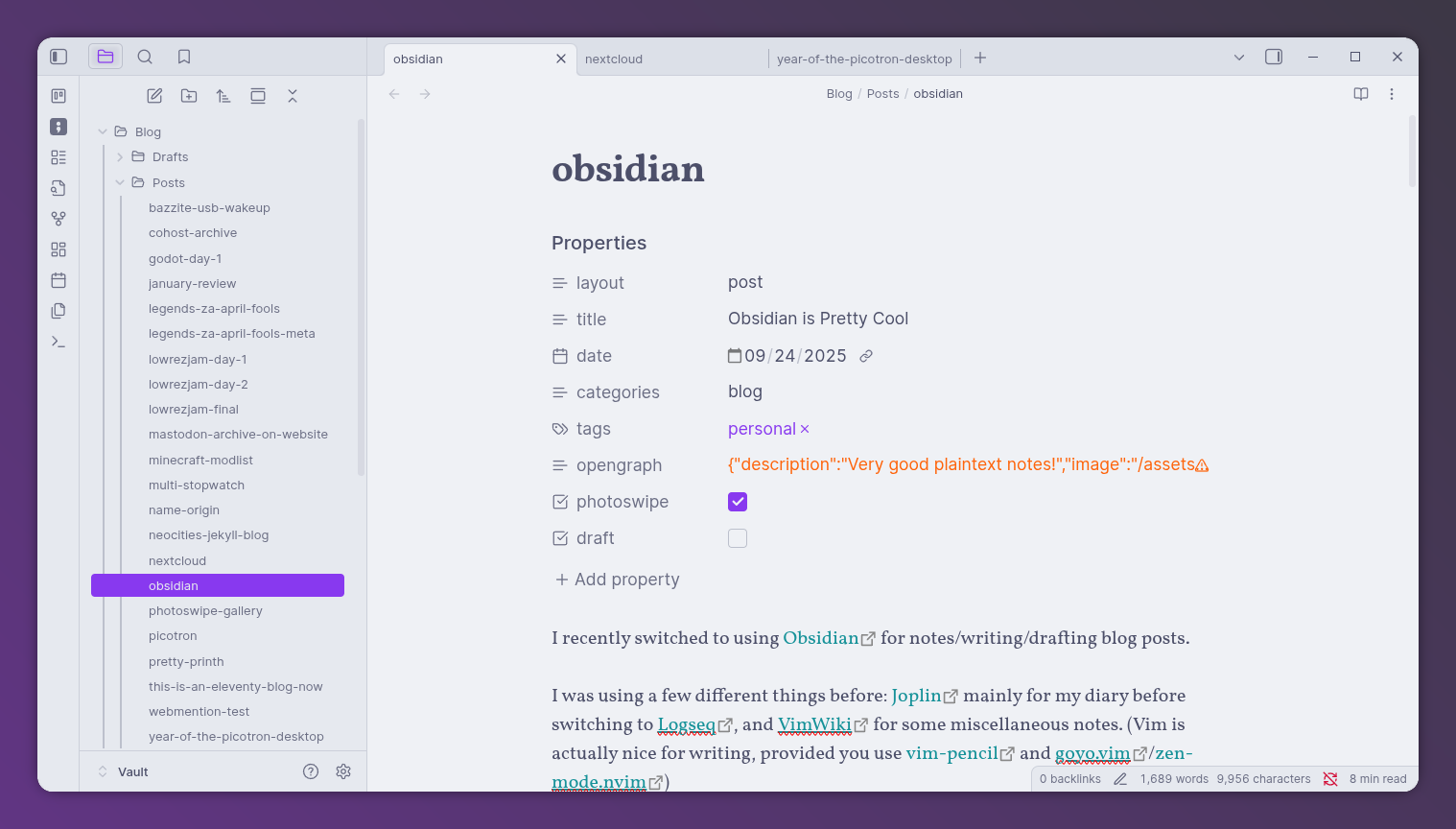Obsidian is Pretty Cool
I recently switched to using Obsidian for notes/writing.
I was using a few different things before: Joplin mainly for my diary before switching to Logseq, and VimWiki for some miscellaneous notes. (Vim is actually nice for writing, provided you use vim-pencil and goyo.vim/zen-mode.nvim)
I was hesitant to try Obsidian, because I heard it wasn’t open source. It’s not that I refuse to use closed source software or anything, but I kinda assumed it was a freemium cloud based thingy, and honestly I’d rather have my notes be entirely local if I can help it.
Luckily, that’s not what Obsidian is. Yes, there is a premium version with syncing and whatnot, but the free version is entirely offline, and entirely plain text! Obsidian just uses regular markdown files, with no fancy formatting or anything (barring plugins), so I’m not tied to Obsidian at all. I could use Notepad to edit my Obsidian vault if I wanted!
Obsidian has a lot of features, and in the past couple of months I’ve been using it I’ve barely scratched the surface of the cool stuff it can do.
About Nextcloud #
So, in my last blog post, I talked about setting up a Nextcloud instance on an old PC. Unfortunately, it died.
Well, it never fully died. Technically, it was still working up until I shut it off, and if I turned the computer back on I’m sure it would keep chugging along no problem. The Nextcloud snap is actually really good, and once I got everything set up initially I had no problems with it at all. Unfortunately, the web interface was really, really slow. Because of that slowness, I pretty much never used it.
I was using Nextcloud entirely as a sync client. It was just a waste of resources, when I could just use Syncthing to do the same thing. So, I hooked up a spare SSD to my Raspberry Pi, put Syncthing on it, and that was that.[1]
The reason I bring this up is that one of my initial reasons for using Syncthing was a blog post by Veronica Explains about using VimWiki with Nextcloud Notes. One of the complaints I had when using Nextcloud Notes was that it doesn’t support the [[wikilink]] syntax. But Obsidian does!
VimWiki #
The only thing I actually needed to do to get VimWiki and Obsidian to work together is to point VimWiki to my obsidian vault. (I also set the index page and diary subfolder to use a capital first letter, because I think it looks better.)
let g:vimwiki_list = [{
\ 'path': '~/Obsidian/Vault/',
\ 'syntax': 'markdown', 'ext': 'md',
\ 'index': 'Index',
\ 'diary_rel_path': 'Diary/'
\ }]The only issue I’ve noticed so far is that for wikilinks, VimWiki requires absolute paths, and Obsidian accepts absolute or relative paths.[2] That’s not a big deal, since I can just use absolute paths anyway, but it’s something to keep in mind.
wiki.vim is an alternative wiki plugin, that might be able to solve this. Specifically, there’s this issue about using a custom link resolver to have better interoperability with Obsidian, though I haven’t tried it.
There’s also obsidian.nvim, which might integrate even better, though again I haven’t tried it.
These might be worth trying in the future, but I’m mostly happy with VimWiki for now.
Settings and Plugins #
Here are some of the settings and plugins I’m using so far.
I have Editor > Files and Links > Default location for new notes set to Same folder as current file. This is what I want most of the time, and it’s annoying to move notes on mobile.
You can set daily notes to open on startup, but it’s disabled by default. Personally, I like it being disabled. I don’t always write a diary entry every day, so it can be annoying to have it always open first thing (this was one of the things I didn’t like about Logseq.)
The Slash commands core plugin is useful to quickly run a command while typing. For example, I am writing this at 2025-09-23 05:17 PM, which I can access by typing /date /time. On desktop, Ctrl+P can do the same thing but slash commands are more convenient, especially on mobile.
Despite being a big vim user, I am not using the vim keybinding in Obsidian. If I want to use vim bindings, I can just use vim directly. Besides, sometimes having partial vim commands is worse than having none, because it can lead to accidentally using a command that doesn’t work. (I try to use Ctrl+w to delete the previous word in insert mode… Oops, that actually closed the tab!)
The theme I’m using is Catppuccin, which looks very nice as always.
Tldraw is a plugin that lets you make whiteboards in Obsidian.
I like using Kanban boards for to-do lists, but it’s really hard to find a good one that isn’t cloud based. Kanban adds some special formatting to create a Kanban board. I think it works very well.
Reading Time is a simple plugin that adds estimated reading time to the status bar, which can be helpful for getting a good idea about how long a document is, especially for things that are going to be published, such as blog posts and fiction.
Smart Typography is a cool plugin that makes it easier to type certain special characters—such as em dashes![3] And ellipsis… And even “smart quotes”. While typing these isn’t very hard on desktop (thanks to the wonderful compose key!)[4], mobile is a different story. But with this plugin, I can simply type three dots to get an ellipsis, or three dashes to get an em dash.
I only have two complaints with it.
- Three dashes is also how you type a horizontal rule. It’s annoying to get an em dash when you want an hr. Thankfully, you can also insert a horizontal rule using a slash command.
- On mobile, if I swipe type a contraction, it doesn’t insert a smart apostrophe. This means I either need to put up with inconsistent apostrophes (yuck!) or I need to manually fix them. It’s not a huge deal, because it only happens when swipe typing, but it’s kinda annoying.
Writing #
Aside from a diary/jotting random things down, the main thing I’ve been using Obsidian for is writing. Obviously, I have this blog, but I’ve also started writing some (fan)fiction recently. For writing prose, I was using LibreOffice Writer before. Many word processors on Android suck, though, so I was mainly writing on my laptop.
I like writing on my phone. Swipe typing is really good, and I like being able to just write a little bit at a time when I have the chance.
I wrote this entire blog post using Obsidian.

Since my blog is also using markdown, there wasn’t much of a difference. Formatting, footnotes, everything works. Even the frontmatter is displayed nicely![5] The only thing that doesn’t really work is image embeds. Obsidian supports images, but I’m using a liquid tag to insert a custom template for images in my blog, which Obsidian obviously doesn’t support. It would be nice to have images appear when using writing a blog post in Obsidian, but it’s not a big deal.[6]
Synchronizing Obsidian and my Blog #
I’m using this script to sync my blog posts from Obsidian to the blog.
#!/usr/bin/env bash
POSTS="$HOME/Obsidian/Vault/Blog/Posts/"
DRAFTS="$HOME/Obsidian/Vault/Blog/Drafts/"
rsync -avz --delete --link-dest="$POSTS" "$POSTS" _posts/
rsync -avz --delete --link-dest="$DRAFTS" "$DRAFTS" _drafts/It hard links my drafts from my Obsidian vault to the blog folder. I only need to re-run it if I created/deleted/moved/renamed a blog post. With this, I can edit a blog post in Obsidian, and have it live previewed with eleventy --serve with no additional interaction.
Technically, you don’t need Syncthing on a server because it’s all peer-to-peer, but it can make syncing more reliable if some devices are offline. I got a new phone recently, so I haven’t been having trouble with Android killing Syncthing on there, but on my 6 year old tablet it’s an issue sometimes. ↩︎
Under
Settings > Files and Links > New Link Format, you can set Obsidian to always use Absolute Paths. ↩︎No, I’m not an AI. ↩︎
Em dash is
Compose+---and ellipsis isCompose+... Smart quotes are harder though. It’sCompose+<"for the opening ones andCompose+>"to close them. ↩︎Obsidian supports adding properties to files in YAML format, same as the 11ty/Jekyll/whatever frontmatter. You can use this to do database queries in Obsidian. This is cool, but I can’t really think of anything I would need that for…
Obsidian doesn’t seem to support nested objects. The way I have my opengraph metadata formatted, I can’t edit it in Obsidian. It might be a good idea to change that. ↩︎Also, I’d need to include my blog images in my Obsidian vault. :/ ↩︎

